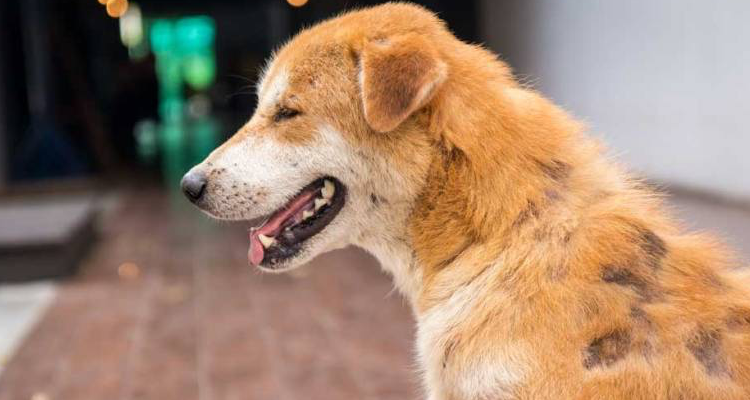Itchiness, inflammation and sneezing are just a few of the symptoms caused by allergic reactions in dogs. Sadly, for our pups, there are countless allergens in the air and environment which can make our sensitive pooches distressed and uncomfortable. This unfortunately can make diagnosis and treatment an uphill battle. But there is light at the end of that gloomy tunnel, and the first step towards treatment is being able to recognise the initial signs of your dog’s allergies.
Read on to discover how to spot an allergic reaction, and a few tips on how you can help your dog relieve their symptoms with treatment.
What are the symptoms of a dog allergic reaction?
- Itchiness: Excessive itching, licking or biting, which may lead to very sore or even infected areas of skin, is one sign of a possible allergic reaction.
- Swelling: watch out for signs of swelling, especially on or around your dog’s face.
- Upset tummy: vomiting and or diarrhoea could be signs of an allergic reaction, but if it’s an allergic reaction to food, there will often be other, external symptoms, too.
- Sinus trouble: your dog may respond to some allergens in a very recognisable way; sneezing and breathing difficulty.
- Hair loss: A normal level of shedding is to be expected with dogs of all shapes and sizes, but if you spot bald patches, that’s a warning sign of an allergy issue.
- Anaphylaxis: probably the most troubling and serious of all allergic reactions, anaphylactic shock can be very distressing, with symptoms ranging from weakness to collapse and in very serious cases could also be fatal.
Let’s take a look at the signs of a possible allergic reaction in a bit more detail.
1. Itchiness

Itching is one of the most common signs of an allergic reaction in dogs. Your dog may be itchy in one specific area or all over their body, with the ears, paws, face, armpits and backend being the most frequent areas affected when allergies strike. You may notice your dog often scratches, bites or licks these spots, which over time can lead to inflammation and hair loss. If your dog’s allergies are severe or prolonged they can traumatise their skin through scratching, causing open wounds and infection. It’s important you seek veterinary advice when you first notice your dog is scratching more than normal. Treatment can help prevent significant flare-ups and keep your dog comfortable.
2. Swelling
Allergies can cause swelling anywhere on your dog’s body, but the face is most commonly affected. Facial swelling can be worrying for owners when they see puffiness around their dog’s eyes, muzzle or ears. It’s more noticeable in short-haired breeds but any dog with allergies can experience swelling. This symptom is usually paired with itching, so you may find your dog also scratches or rubs at their face. This associated scratching will likely be the main indicator of an allergy issue if you have a long-coated dog. Swelling from allergies is easily treated with medication and can give your pooch almost instant relief from their symptoms.
3. Upset tummy
Vomiting and diarrhoea symptoms often indicate a food allergy, but digestive issues can flare up from any type of allergen. If your dog is allergic to a certain food, they may have both an upset stomach as well as skin problems, or they could have itchiness without the vomiting and diarrhoea. Dogs with food sensitivities tend to have more problems with ingredients such as beef, pork, lamb, dairy products, wheat and corn. But the problem could quite easily be any type of food which is why it’s so difficult to diagnose. If your dog’s allergies aren’t seasonal, the problem is more likely to do with food and your vet will suggest tests or a new diet plan you can try.
4. Sinus trouble
Various allergens in the environment can cause inflammation and congestion in your dog’s sinuses. Think about the last time you had a heavy cold and the range of unpleasant symptoms you experienced. You probably felt bunged up and miserable, right? If your dog has a sinus allergy you may notice a clear discharge from the eyes and nose, tender and inflamed nasal cavities, red and inflamed eyes, breathing difficulty and sneezing. Your vet will usually be able to diagnose a sinus allergy from your dog’s symptoms and will suggest methods to uncover the culprit.
5. Hair loss
Fur shedding is normal to a degree, but if your dog has significant thinning or bald patches they are likely allergic to something in the environment. Hair loss can be caused by an allergic reaction to food, fleas, or by coming into physical contact with an allergen. The fur loss can occur anywhere on your dog’s body and can happen gradually over time, or as a result of constant licking and scratching. If your dog’s fur is thinning or patchy you should speak with your vet quickly as it can spread all over the body if left untreated.
6. Anaphylaxis
Anaphylaxis is a severe allergic reaction that usually happens within minutes of your dog coming into contact with the allergen. The symptoms of anaphylactic shock include difficulty breathing, weakness, collapse and losing control of the bowels and bladder. It can be fatal and affect major organs, which is why it should always be seen as an emergency situation. Dogs can experience anaphylaxis to any type of allergen but is more common after they’ve been given a vaccine. If your dog has an anaphylactic reaction you should rush them straight to the vets for immediate treatment.
How long does it take for an allergic reaction in dogs?
The time it takes to visibly see your dog’s allergy symptoms will depend on the type of reaction and their sensitivity to the allergen. With serious anaphylactic reactions as mentioned above, symptoms occur within mere seconds to minutes after exposure.
Facial swelling from allergies is generally not life-threatening and usually occurs within 30 minutes to a few hours after exposure to the allergen. If left untreated, the swelling may reduce after one to two days, but prolonged exposure to allergens will need diagnosis and treatment to help your dog lead a more comfortable life.
With skin allergies, the problem can occur gradually over your dog’s lifetime or within a few hours of coming into contact with the allergen. Skin allergies can be brought on by increased pollen, mould and fungus levels in the environment, which means allergies gradually occur as the seasons change.
In some dogs, food allergies can develop slowly due to constant exposure to the same ingredients or a poor-quality diet. Prolonged exposure to the same diet can cause intestinal inflammation and a problem called leaky gut syndrome. A condition that damages the intestinal lining to allow toxins and bacteria to enter the bloodstream. When the immune system tries to fight off the toxins this causes an allergic reaction. You may be able to prevent food allergy development by rotating foods and offering a quality higher-protein diet.
Does your dog suffer from allergies? Which treatments have you found to be most effective? Let us know in the comments below or head over to Facebook and Twitter to join the conversation. Don’t forget to tag @DogBuddyCo

